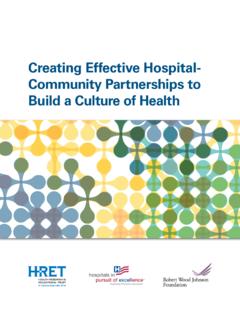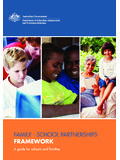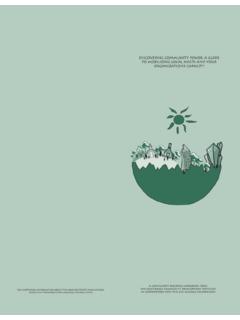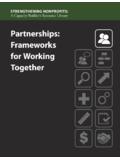Transcription of TRAUMA INFORMED COMMUNITY BUILDING - …
1 TRAUMA INFORMED . COMMUNITY BUILDING . A Model for Strengthening COMMUNITY in TRAUMA Affected Neighborhoods Weinstein, Wolin, Rose TRAUMA INFORMED COMMUNITY BUILDING . A Model for Strengthening COMMUNITY in TRAUMA Affected Neighborhoods BRIDGE HOUSING CORPORATION. BRIDGE Housing Corporation is a leader in the field of affordable housing with over 30 years of real estate development, property management and asset/portfolio management experience. BRIDGE's mission is to strengthen communities by developing, owning, and managing high quality, affordable homes for working families and seniors.
2 Since inception, BRIDGE has believed that an apartment with an affordable rent should be a stepping stone for advancement. Ranked among the most successful in the nation, BRIDGE has developed over 14,000 homes. HEALTH EQUITY INSTITUTE, SAN FRANCISCO STATE UNIVERSITY. Founded in 2006, The Health Equity Institute (HEI) is a research institute at San Francisco State University that links science to COMMUNITY practice in the pursuit of health equity and justice. HEI is a multi-disciplinary team pursuing original research on emerging health equity issues and partnering with communities to understand and address critical health equity issues.
3 Weinstein, Wolin, Rose, May 2014. AUTHORS. Emily Weinstein, MCP, MSRED. Director, Potrero COMMUNITY and Housing Development BRIDGE Housing Corporation Jessica Wolin, MPH, MCRP. Associate Director for COMMUNITY Practice, Health Equity Institute Clinical Faculty, Department of Health Education San Francisco State University Sharon Rose, MPH. Writing Consultant ACKNOWLEDGMENTS. We would like to thank the following people for their contributions to this paper and the development and implementation of the TRAUMA INFORMED COMMUNITY BUILDING Model: City and County of San Francisco Alicia Crawford, BRIDGE Housing Corporation Charmaine Curtis, Curtis Development Jennifer Dhillon, Healthy Generations Project Ken Epstein, San Francisco Department of Public Health Faculty Writing Group, Health Equity Institute, San Francisco State University Cynthia Gomez, Health Equity Institute, San Francisco State University Anne Griffith, Enterprise COMMUNITY Partners, Inc.
4 Lyn Hikida, BRIDGE Housing Corporation Laura Mamo, Health Equity Institute, San Francisco State University Tomiquia Moss, San Francisco Mayor's Office Susan Neufeld, BRIDGE Housing Corporation Cynthia Parker, BRIDGE Housing Corporation Uzuri Pease-Greene, BRIDGE Housing Corporation Ellie Rossiter, San Francisco Foundation Julie Tinker Ward, Tinker Co. And a special thank you to the residents of Potrero Terrace and Annex for their ongoing commitment to their COMMUNITY . 01. TRAUMA INFORMED COMMUNITY BUILDING . A Model for Strengthening COMMUNITY in TRAUMA Affected Neighborhoods TABLE OF CONTENTS.
5 I. INTRODUCTION 03. II. COMMUNITY BUILDING 05. III. TRAUMA AS A CHALLENGE TO. COMMUNITY BUILDING 06. IV. TRAUMA INFORMED COMMUNITY BUILDING 10. CONCLUSION 16. REFERENCES 17. Weinstein, Wolin, Rose, May 2014. I. INTRODUCTION. Across the country efforts to revitalize low-income and public housing are underway as part of large-scale COMMUNITY development initiatives that seek to alleviate poverty and improve neighborhoods. COMMUNITY development is a continuous process of identifying COMMUNITY needs and developing the assets to meet those needs (Green and Haines, 2007). It is well recognized that COMMUNITY development of public housing sites requires extensive COMMUNITY BUILDING , which is the active participation of residents in the process of strengthening COMMUNITY networks, programs and institutions (Naparstek, Dooley & Smith, 1997).
6 Federal housing programs such as HOPE. VI and CHOICE Neighborhoods mandate COMMUNITY leadership as integral to revitalization efforts and have institutionalized this approach by requiring resident involvement in determining COMMUNITY needs and the development of local solutions. This widely supported COMMUNITY BUILDING approach seeks to acknowledge and tap into COMMUNITY assets and to prioritize COMMUNITY member voices and engagement. However, there is a growing understanding that TRAUMA experienced by many low-income and public housing communi- ties present a challenging context for these COMMUNITY BUILDING efforts.
7 TRAUMA is a set of normal human responses to stressful and threatening experiences (National Center for PTSD, 2007). Low-income and public housing residents may experience cumulative TRAUMA resulting from daily stressors of violence and concentrated poverty, as well as historic and structural conditions of racism and disenfranchisement (Collins, et al., 2010). Public housing residents are over twice as likely as the general American population to suffer from gun violence (National Department of Housing and Urban Development [HUD], 2000). In addition, historical TRAUMA due to MORE THAN.
8 A legacy of racism, residential segregation and oppression takes its toll on residents' emotional and physical well-being (Wilson, 1987). For many adults, 70 PERCENT. children and families these conditions cause chronic stress and overwhelm OF AFRICAN-AMERICAN. residents' abilities to cope (Marmot, 2004; Substance Abuse and Mental CHILDREN WHO GROW. Health Services Administration [SAMHSA], 2013). UP IN THE POOREST. NEIGHBORHOODS. Pervasive current and historical TRAUMA demands a COMMUNITY BUILDING REMAIN IN THESE. approach that takes into account residents' emotional needs and avoids NEIGHBORHOODS.
9 Re-traumatization triggers, which traditional models of COMMUNITY BUILDING may ignore or exacerbate. Just as a TRAUMA INFORMED approach is now AS ADULTS. accepted as essential for effective service delivery to many individuals living in these communities (SAMHSA, 2012), a TRAUMA INFORMED approach to COMMUNITY BUILDING is required to create sustainable improvements to their social and physical environment. We present a model of TRAUMA INFORMED COMMUNITY BUILDING (TICB) that addresses the challenges TRAUMA poses to traditional COMMUNITY BUILDING strategies. TICB strategies de-escalate chaos and stress, build social cohesion and foster COMMUNITY resiliency over time.
10 The TICB model is based on BRIDGE Housing Corporation's experience doing COMMUNITY BUILDING work over the past five years in the Potrero Terrace and Annex public housing 03. site in San Francisco. The work in Potrero is part of San Francisco's HOPE SF. initiative, a public-private partnership led by the San Francisco Mayor's Office to rebuild some of the most distressed public housing in San Francisco. The TICB model effectively takes into account the real-life experiences of low- TRAUMA INFORMED . income and public housing residents. Its application ensures that COMMUNITY BUILDING promotes COMMUNITY healing as part of housing COMMUNITY BUILDING .






